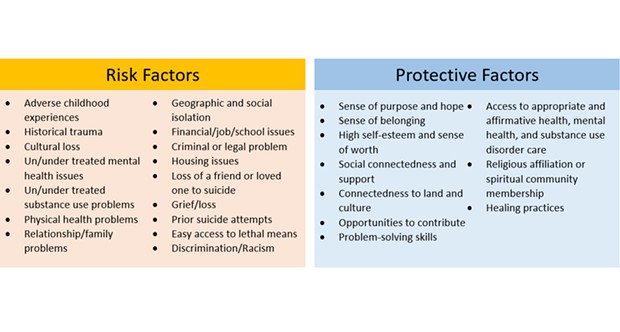Aiming for Zero
A look at Humboldt's multi-disciplinary effort to prevent suicides
By Thadeus Greenson [email protected] @ThadeusGreenson[
{
"name": "Top Stories Video Pair",
"insertPoint": "7",
"component": "17087298",
"parentWrapperClass": "fdn-ads-inline-content-block",
"requiredCountToDisplay": "1"
}
]
For decades, the deadly trend has continued with alarming regularity, though it's not talked about as much as homicides or fatal car crashes. Over the past 20 years, more than 600 Humboldt County residents have died by suicide, an average of more than 30 a year, routinely leaving Humboldt with one of the highest suicide rates in the state.
In 2019, the county launched a multi-agency effort to review each of the county's suicide deaths with the aim of better understanding why and how people take their own lives and opportunities for intervention and prevention. The effort is in its infancy, with its first years having focused on data collection, but officials are optimistic it will move the needle toward the goal of zero suicide deaths.
"It is one of our priority areas because the impact of suicide is profound in the loss of life of the individual, the immediate effect on their family members and the long-term effects on the community as a whole," Humboldt County Health Officer Candy Stockton told the board of supervisors in April while delivering the effort's first annual report.
Under the new protocol, the Humboldt County Coroner's Office has expanded the way it investigates suicide deaths, using a consolidated risk assessment checklist to collect data documenting whether the decedents had experienced problems with physical health, financial stresses, substance use, relationships with an intimate partner or social isolation, as well as what services they'd received and whether they'd disclosed suicidal intent.
That data is then reviewed by the Humboldt County Suicide Fatality Review Board, a multi-disciplinary group, which also reaches out to families of the deceased, requesting permission to review their loved one's case.
"We examine individual deaths to understand circumstances of the suicide, the systems that touched the life of the deceased, the relevant risk and protective factors, and the actions that will improve systems and catalyze prevention," the team's first annual report states.
Preliminary data shows 85 percent of people who died by suicide in 2021 and 2022 identified as male, and their average age was 52, though Stockton indicated that's misleading, as there's a "bimodal peak" of a younger population and an older population that reaches that average.
Some intervention efforts have already begun.
Paul Bugnacki, the county's Department of Health and Human Services Behavioral Health deputy director, said the effort identified the need for more training for not only his department's clinicians but all staff that interface with the public — from the receptionists who answer phones to the custodians on site at facilities — on suicide prevention and warning signs. Meanwhile, Bugnacki said the local Suicide Prevention Network is making similar trainings available to local faith centers, community groups and nonprofit service providers, with the hope that people across a myriad of systems will know what risk factors to look for and what do when they see them.
"It's kind of the no-wrong-door approach," he said.
In her presentation to the board, Stockton noted that she attended one of these trainings in her prior role as the chief medical officer of the Humboldt Independent Practice Association and said it made a marked difference in her ability to respond to people experiencing suicidal thoughts.
A hard truth in this conversation is that Humboldt County is rife with the issues identified as risk factors for suicide, with generally poor physical health outcomes and elevated rates of substance use disorders, poverty and intimate partner violence compared to state and national averages. Bugnacki also pointed out that Humboldt County has high rates of ACEs — or the adverse childhood experiences that quantify childhood trauma and have been proven to lead to higher rates of poor physical and social health — as well as "a lot of historical trauma." Those realities necessitate prioritizing intervention and prevention.
In addition to training people to recognize warnings signs, another effort already well underway is the lethal means safety project, which distributes free lockboxes for people to secure their firearms and/or prescription medications. In a county in which opioid medications are prescribed at a rate of 526 prescriptions per 1,000 residents and firearm ownership is widespread, such efforts can be potentially critically impactful.
The Suicide Fatality Review report for 2022 analyzed cases from 2021 and 2022 and found that of the 66 suicide deaths documented, a firearm was used in more than half, while national studies have found firearms and poisoning — most commonly through medications — as leading means of suicide.
In his book Talking to Strangers, best-selling author Malcolm Gladwell looks at the role of "coupling" in suicide, or the idea that someone acting on suicidal ideations is often linked to the availability of a means they are comfortable with at a moment of crisis. The book referenced a study of suicide deaths in England between 1963 and 1975, which found a steady decline as the country transitioned its public natural gas supply to remove carbon monoxide, which had been a readily available and leading means of suicide deaths. Gladwell argues the study's findings show that suicide often occurs at a nexus of transient despair and ready access to a means of death the person finds "neither too difficult nor repugnant." When that ready access was removed by the transition away from a gas supply heavy in carbon monoxide, suicide rates decreased, indicating those experiencing despair did not simply find another means. Similarly, Gladwell looked at a study that tracked down more than 500 people who'd been restrained from jumping off the Golden Gate Bridge and found that the vast majority — 75 percent — had not attempted suicide again. The takeaway, Gladwell argues, is that preventing easy access to a deadly means someone finds acceptable in a moment of crisis might prevent them from ever attempting suicide.
In the case of the lockbox program, Stockton said during her presentation to the board that gun shops have been receptive to distributing the boxes and providing information about how gun owners can keep themselves and their loved ones safe. Supervisor Rex Bohn commented that the lock boxes don't prevent the "person who has control of the gun" from accessing it, but Stockton responded that she's found people have often been receptive to the idea of having family members or trusted friends take possession of their firearms for a temporary period when they're in a time of crisis.
"It's easy to expect that many people wouldn't be receptive, but I've found that many are," she said.
Most agree investment in crucial mental health infrastructure — a youth residential facility that could keep more kids in crisis in the local area, step-down residential facilities for adults, more mental health clinicians — is needed and the Suicide Fatality Review Board has more analysis to do before making formal recommendations. But in the meantime, Stockton and Bugnacki indicated increased awareness and cooperation across systems, organizations and community members can make a big difference.
Stockton said recognizing risk signs — mental health issues, physical health problems, financial insecurity, relationship problems, grief, isolation and substance use issues — and becoming familiar with resources [the county's 24-hour crisis line at (707) 445-7715 or texting HOME to 741741] is something all community members can do in order to be ready to help when needed. She told the board there's a stigma around suicide that causes some to believe that talking about it will somehow cause someone to consider it, but "the data really clearly shows that that's not the case."
"One of the best things you can do as a member of our community is just, if you see someone you are concerned about, just ask, 'Are you alright?'" she said. "That interaction could make the difference between someone reaching out for help and not reaching out."
Thadeus Greenson (he/him) is the Journal's news editor. Reach him at (707) 442-1400, extension 321, or [email protected].
more from the author
-
Deputy Shoots Cutten Shooting Suspect
- Apr 25, 2024
-
Arcata Lowers Earth Flag as Initiative Proponents Promise Appeal
- Apr 25, 2024
-
Officials Weigh in on SCOTUS Case's Local Implications
- Apr 25, 2024
- More »
Latest in News
Readers also liked…
-
Through Mark Larson's Lens
A local photographer's favorite images of 2022 in Humboldt
- Jan 5, 2023
-
'To Celebrate Our Sovereignty'
Yurok Tribe to host gathering honoring 'ultimate river warrior' on the anniversary of the U.S. Supreme Court ruling that changed everything
- Jun 8, 2023


































